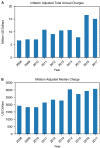Emergency Department Presentations of Acute Primary Angle Closure in the United States from 2008 to 2017
- PMID: 35924186
- PMCID: PMC9342660
- DOI: 10.2147/OPTH.S368453
Emergency Department Presentations of Acute Primary Angle Closure in the United States from 2008 to 2017
Abstract
Purpose: Acute primary angle closure (APAC) is an ophthalmologic emergency. Nationwide data on the epidemiology and clinical characteristics of APAC are lacking despite the associated visual morbidity.
Patients and methods: A retrospective cross-sectional study using the Nationwide Emergency Department Sample (NEDS). The NEDS was queried by ICD-9/10 code for cases of APAC presenting to the United States emergency departments over a ten-year period from 2008 to 2017. All identified cases were included to produce nationally representative estimates. Linear regression and seasonality tests were used to identify trends. Reported outcomes include the incidence, demographics, seasonality, and economic impact of APAC regionally and nationwide.
Results: A total of 23,203 APAC-related ED visits were identified. The mean (SD) and median ages were 58.8 (16.2) and 60 years, respectively. Females (59.4%, p < 0.01), those in the lowest income quartile (6983, 30.1%, p < 0.01), and those in the seventh decade of life (5599, 24.1%) presented more frequently with APAC. The incidence of ED presentations within each age group rose with age and increased significantly over the study period (p < 0.01). The Northeast region had the highest average incidence (0.93 per 100,000 population). Significant seasonal variation was seen regionally and nationally (p < 0.01), with the highest average incidence in December and lowest in April. Median inflation adjusted charge per ED visit was $2496.10, and the total inflation adjusted charges equaled $101.5 million.
Conclusion: The incidence of APAC-related ED visits continues to rise in the United States. High-risk groups include women, individuals of low socioeconomic status, and those between ages 50 and 70. Significant seasonal and regional trends were observed in ED presentations of APAC.
Keywords: cost; demographics; glaucoma; incidence; seasonality.
© 2022 Mehta et al.
Conflict of interest statement
All authors report no conflicts of interest in this work.
Figures




Similar articles
-
Incidence, admission rates, and economic burden of pediatric emergency department visits for urinary tract infection: data from the nationwide emergency department sample, 2006 to 2011.J Pediatr Urol. 2015 Oct;11(5):246.e1-8. doi: 10.1016/j.jpurol.2014.10.005. Epub 2015 Feb 7. J Pediatr Urol. 2015. PMID: 26005017
-
Outcomes in patients visiting hospital emergency departments in the United States because of periodontal conditions.J Periodontol. 2011 Jun;82(6):809-19. doi: 10.1902/jop.2010.100228. Epub 2010 Dec 7. J Periodontol. 2011. PMID: 21138352
-
Ocular Injury in United States Emergency Departments: Seasonality and Annual Trends Estimated from a Nationally Representative Dataset.Am J Ophthalmol. 2018 Jul;191:149-155. doi: 10.1016/j.ajo.2018.04.020. Epub 2018 May 9. Am J Ophthalmol. 2018. PMID: 29750945 Free PMC article.
-
Characteristics of Orbital Floor Fractures in the United States from 2006 to 2017.Ophthalmology. 2021 Mar;128(3):463-470. doi: 10.1016/j.ophtha.2020.06.065. Epub 2020 Jul 10. Ophthalmology. 2021. PMID: 32659309
-
Emergency department factors associated with survival after sudden cardiac arrest.Resuscitation. 2013 Mar;84(3):292-7. doi: 10.1016/j.resuscitation.2012.10.013. Epub 2012 Oct 24. Resuscitation. 2013. PMID: 23103887 Review.
References
LinkOut - more resources
Full Text Sources
Miscellaneous

